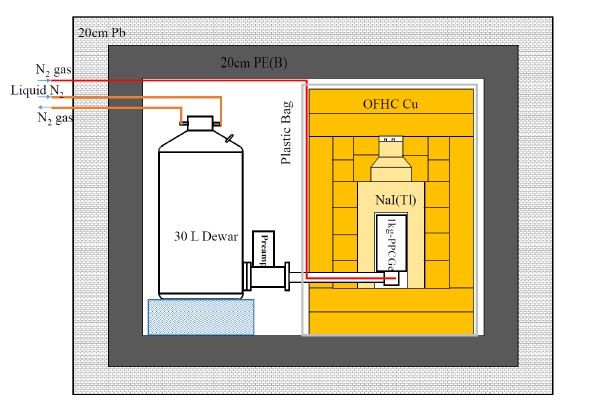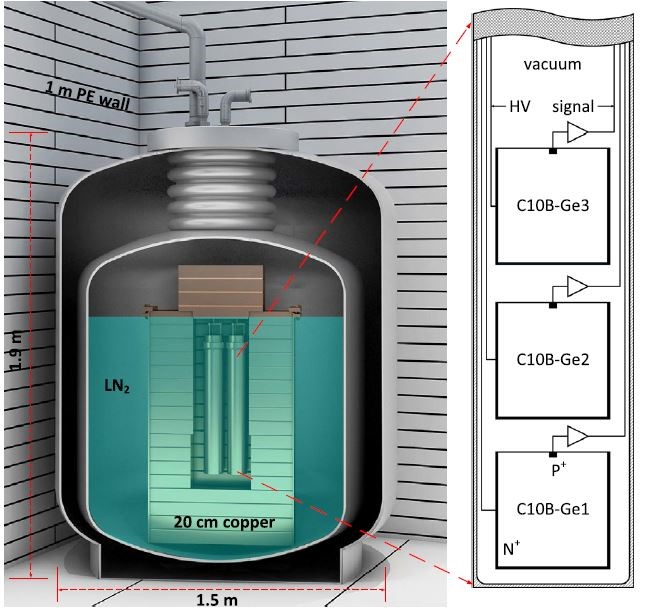The CDEX collaboration has been established for direct detection of light dark matter particles, using ultra-low energy threshold point-contact p-type germanium detectors, in China JinPing underground Laboratory(CJPL). The first 1 kg point-contact germanium detector (CDEX-1) with a sub-keV energy threshold has been tested in a passive shielding system located in CJPL.

Figure 1. Schematic diagram of CDEX-1 experimental setup
The NaI(Tl) scintillator crystal of the AC detector is well-shaped which can enclose the cryostat of the pPCGe, as shown above, and the thickness of its side and top is 48 mm and 130 mm, respectively. The scintillation light from NaI(Tl) crystal were read out by a photomultiplier tube (PMT), which has two outputs from anode and dynode respectively, one was loaded to a shaping amplier at high gain determining the time over NaI-AC energy threshold, and another was loaded to a timing amplier at low gain, which was used to measure energy as well as discriminate background sources based on pulse characteristics for different radiation.
The outermost is 20 cm of lead to shield ambient gamma ray. The inner is 20 cm thick layer of 30% borated polyethylene, acting as thermal neutron absorber. At phase I experiment, the innermost is a minimum of 20 cm of Oxygen Free High Conductivity (OFHC) copper surrounding the 994 g pPCGe detector cryostat in all directions, to further reduce gamma ray surviving from outer shield. Exterior to the OFHC shield is a plastic bag which is used to seal the working space to prevent radon incursion. The radon exclusion volume is continuously ushed with nitrogen gas from a pressurized Dewar. At phase II experiment, interior to OFHC shield is a NaI-AC detector with a well-shaped cavity enclosing the pPCGe detector cryostat to provide passive and active shielding.


Figure 2. The 90% confidence level upper limit of (a) spin- independent -N coupling and (b) spin-dependent -neutron cross-sections. The CDEX-1 results from this work are de- picted in solid black.
Exclusion plots at 90% confidence level were shown in Figure (a), together with bounds and allowed regions from several representative experiments. The sensitivities has been improved a few times over our work last year due to several times larger exposure. Most of the light WIMP regions within 6 and 20 GeV/c2 implied by earlier experiments are probed and rejected.
The limits on spin-dependent (denoted by n) cross sections were also extracted. Exclusion plots plane at 90% confidence level for light WIMPs was also derived, as depicted in Figure (b), and bounds from other benchmark experiments are also superimposed.
Toward a future ton-scale DM experiment, the second generation CDEX experiment with a total detector mass of about 10 kg, called CDEX-10, has used three triple-element pPCGe strings (C10A, B, C) directly immersed in liquid nitrogen (LN2). CDEX-10 focuses on the arraying technologies and background understanding of the prototype pPCGe detectors developed based on the CDEX-1 technique. The new CDEX-10 array detectors and dedicated data acquisition (DAQ) system started testing and data taking inside a LN2 tank in 2016 at CJPL.

Figure 3. Configuration of CDEX-10 experimental setup (left) and C10B detector layout inside the string (right).
The stainless steel LN2 tank was located in the polyethylene room with 1 m thick walls at CJPL-I for cooling of the CDEX-10 detectors, which are surrounded by 20 cm thick high-purity oxygen-free copper immersed in LN2 to shield the ambient radioactivities. The shielding configuration of CDEX-10 and the structure of a detector string are shown in Figure above.

Figure 4. Exclusion plots of (a) SI χ-N coupling and (b) SD χ-neutron coupling at 90% C.L., superimposed with results from other benchmark direct search experiments
The best published limits on SI χ-N couplings from the LHC CMS and ATLAS experiments are more stringent and beyond the σ scale displayed in (a), though they are extremely model and parameter dependent. New regions on SI for mχ at 4–5 GeV/c2 are probed and excluded, while liquid xenon experiments provide more stringent constraints at mχ > 5 GeV/c2. The potential reach with target sensitivities of a 100 eVee threshold at 0.1 /kg/keVee/day background level for 10 kg yr exposure are also superimposed both for SI and SD couplings.
In the CDEX-300 stage, a 300kg-scale enriched germanium detector array (76Ge abundance>86%, and the total mass of germanium metal used in making detectors is about 300kg) will be built in the 1725m³ liquid nitrogen tank at Hall-C of the CJPL Phase-II. Those high-purity germanium detectors will be arranged in series, a total of 19 strings, each string of 10 or 11 detectors, a total of 200 detectors. The baseline of the detector is the Broad Energy Germanium (BEGe), with a single mass of about 1.12 kg and a total mass of about 225 kg.
The enriched germanium detector array will be immersed into the liquid argon with a diameter of 1.5m and a depth of 8m to maintain a low temperature. At the same time, the liquid argon will be purified to 9N, and the liquid argon scintillation light will be read by a wavelength-shift fiber system to provide the enriched germanium detector array a considerable background depression capability via anti-coincidence.
The CDEX-300 experiment, which is expected to be completed in 2027, will have a background level of 1.0×10-4 cpkky. Operating under this background for 3 years, the exposure will reach 1 ton-year by 2030, and the half-life sensitivity will be greater than 1027 years, entering the sensitive parameter space of inverted hierarchy mass region.
You can find more details in Publication --> Public Data-->CDEX-DBD proposal.
In the CDEX-1T stage, three more enriched germanium arrays were added to the existing CDEX-300 liquid nitrogen cryostat, the target mass of each array will reach 250kg, and the total mass of the detector will reach about 1 ton. The liquid argon anti-coincidence system will be adopted with subterranean depleted argon, which can significantly reduce the background contribution of Ar radioisotopes. At this stage, most of the enriched germanium crystal growth and detector fabrication process will be completed in the underground laboratory, and the total background of CDEX-1T will be further reduced to 5.0×10-6 cpkky. After 5 years of operation, it will reach an exposure of 5 ton-year, the sensitivity of half-life measurement will increase to 1028 years, and a complete scan of the parameter space of inverted hierarchy neutrino mass region will be completed.